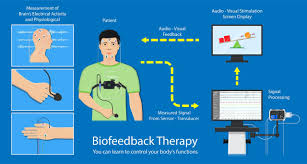Harnessing the Power of Mind-Body Connection
In today’s world of fast-paced living, stress, anxiety, and chronic health issues are becoming increasingly common. Many people are now turning to holistic approaches to manage their well-being. Among these,it has gained popularity as a safe, non-invasive, and effective method to improve health by tapping into the body’s natural processes. By learning to control certain physiological functions, biofeedback empowers individuals to heal and maintain balance.
What is Biofeedback Therapy?
it therapy is a technique that teaches individuals to control bodily processes that are usually involuntary, such as heart rate, muscle tension, blood pressure, and breathing. During a biofeedback session, sensors are attached to the body to monitor functions like brain waves, skin temperature, or muscle activity. This information is displayed on a screen in real-time, allowing individuals to see how their body responds to stress, thoughts, and emotions.
The goal is to make people more aware of these subtle changes so they can consciously regulate them. For example, a person who suffers from migraines can learn to recognize early signs of muscle tension and use relaxation techniques to prevent an episode.
How Does Biofeedback Therapy Work?
The therapy relies on the principle of self-regulation. When we are stressed, our body reacts—heart rate rises, muscles tighten, and breathing becomes shallow. By providing feedback about these physiological changes, biofeedback helps individuals practice controlling them.
Here’s how a typical session works:
- Monitoring: Sensors are attached to specific areas of the body, depending on what is being measured.
- Feedback: Data is displayed as visuals, sounds, or graphs on a monitor.
- Training: The therapist guides the patient in relaxation techniques, such as deep breathing, meditation, or visualization.
- Control: Over time, patients learn to voluntarily adjust their responses to stress and other triggers without the help of machines.
With practice, this control becomes natural, even outside therapy sessions.
Types of Biofeedback Therapy
itcan target different physiological functions. Some common types include:
- Electromyography (EMG): Measures muscle tension and is useful for conditions like headaches, back pain, or anxiety.
- Neurofeedback (EEG Biofeedback): Tracks brainwave activity and is used for ADHD, insomnia, and depression.
- Thermal Biofeedback: Monitors skin temperature, often applied for stress management and circulatory issues.
- Heart Rate Variability (HRV): Focuses on heart rate patterns, beneficial for stress, anxiety, and cardiovascular health.
- Respiratory Helps individuals improve breathing patterns, useful for asthma and anxiety disorders.
Each type addresses specific health concerns, but all aim to improve self-awareness and control.
1. Stress and Anxiety Reduction
It is especially effective in teaching relaxation techniques that reduce stress hormones. As people become more aware of their body’s stress responses, they learn to calm themselves, lowering anxiety levels.
2. Chronic Pain Management
Conditions like migraines, tension headaches, and lower back pain often improve with biofeedback, as patients learn to relax muscles and reduce pain triggers.
3. Improved Sleep
Insomnia and disturbed sleep patterns can be addressed through neurofeedback and relaxation techniques that promote deeper, restorative sleep.
4. Better Mental Health
ithelps manage depression, PTSD, and ADHD by training individuals to regulate emotional and physical responses.
5. Enhanced Physical Health
It can aid in treating high blood pressure, digestive disorders, asthma, and even recovery after a stroke, by strengthening mind-body communication.
6. No Side Effects
Unlike medications, it is non-invasive and free from side effects, making it safe for children, adults, and elderly patients.
Who Can Benefit from Biofeedback Therapy?

this therapy is suitable for people of all ages who are dealing with:
- Stress and anxiety disorders
- Headaches and migraines
- Hypertension (high blood pressure)
- ADHD and learning difficulties
- Sleep disorders
- Asthma and respiratory issues
- Muscle pain and injuries
- Irritable Bowel Syndrome (IBS)
It is also used by athletes and professionals to enhance focus, performance, and stress resilience.
What to Expect in a Biofeedback Session
this session usually lasts between 30 to 60 minutes. The therapist first identifies the symptoms or conditions to address. Sensors are then placed on the body to track physiological activity.
The patient watches this activity on a screen in real time while the therapist introduces relaxation or mental exercises. With repeated sessions, patients learn to control their body’s responses. Most individuals require 8–10 sessions for noticeable results, although some conditions may need more.
Limitations of Biofeedback Therapy
While biofeedback is highly beneficial, it has some limitations:
- It requires consistency and multiple sessions to be effective.
- Not all insurance plans cover biofeedback therapy.
- It should not replace medical treatment for severe conditions but can be used alongside it.
- Some patients may find the equipment intimidating in the beginning.
Despite these challenges, it remains a valuable complementary therapy for long-term wellness.
Final Thoughts
bridges the gap between mind and body, empowering individuals to take charge of their health. By providing real-time insights into bodily processes, it transforms unconscious reactions into conscious control. Whether you’re struggling with stress, chronic pain, or mental health challenges, it offers a natural and effective way to restore balance.
As healthcare continues to embrace holistic approaches, stands out as a scientifically proven method that blends technology with self-awareness. With practice and dedication, it allows you to unlock the power of your mind to heal your body.
